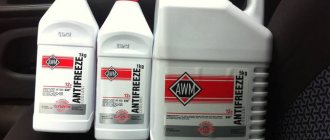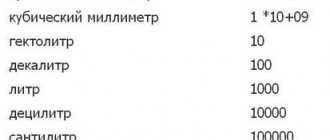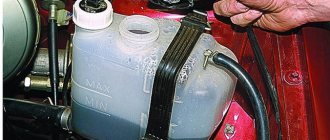Converting kilograms, centners and tons to liters can be done using any publicly available online unit converter. Such applications are suitable for solving most mathematical and physical problems. But when it comes to fuel, in particular gasoline, a simple translation is not enough. To correctly calculate the number of liters in one ton of fuel, you will need to take into account some other characteristics of the fuel.
In Bashkiria, both the birth rate and death rate decreased in the first quarter of 2022
How many liters of diesel fuel are in 1 ton: how to convert mass into volume
Infant mortality has also increased: in January-March last year, 72 infants (children under 1 year of age) died, in the first quarter of this year - 76. The Ministry of Health plans to overcome the problem by implementing plan of activities determined by the national project “Healthcare”. The causes of death remain the same. Mortality from cardiovascular diseases increased by 16%, mortality from cancer decreased by 3%, and from external causes - by 29%. But at the same time, the death rate from road accidents increased by 30% - in the first quarter, 21 more people died on the roads. Earlier, Bashinform reported that scientists from the Institute of Strategic Studies of Bashkiria have recorded certain features of the distribution of causes of death depending on place of residence. Most people die from infections and cancer in cities. In villages, the most common causes of death are diseases of the respiratory system, digestion, genitourinary system and external causes.
Density of different types of diesel fuel
How many cubic meters of gas are in a 50 liter propane cylinder?
All diesel fuel is divided into different types and is not standard. There are at least three types: summer, winter, arctic fuel. The density is different, and in order to calculate how many liters of diesel fuel are in 1 ton, we need to know this value.
So, summer diesel fuel has a density of 860 kg/m3. This diesel fuel is distinguished by its operating temperature range. At 10 degrees above zero, this fuel may begin to solidify. The temperature at which a flash is possible is 45 degrees above zero. It is usually sold in hot countries.
Winter diesel fuel has a density of 840 kg/m3. It does not harden at temperatures not lower than -35 degrees. Therefore, this fuel is effective in winter. Ignition is possible at 40 degrees Celsius.
There is also Arctic diesel fuel, which is rarely found at gas stations in the city. Its density is 830 kg/m3. It can ignite at 35 degrees Celsius.
If this product is sold in large volumes, the calculation is made in tons, not in liters. This is because liquid can contract or expand at low and high temperatures, respectively. Consequently, the volume will increase or decrease, but the mass will remain constant. Of course, you can buy it in liters, but then there may be a high error for better or worse for the buyer or seller.
His Majesty coefficient
1 cubic meter of diesel fuel, how many tons, how many liters in 1 kg of diesel fuel
For simplified and correct conversion, the Ministry of Industry and Energy of Russia made a truly Solomon-like decision to introduce fixed average density values for all types of liquid hydrocarbon fuels. Now accountants and all interested parties do not have to agonize over how to convert the number of liters of gasoline into tons. It is enough just to look at the corresponding table of coefficients and substitute the required value from there into the following formula: M = Vρ. It must be remembered that the result of such a simple calculation will be kilograms, which can only be converted into tons.
The coefficients for the most common and frequently used brands of gasoline are as follows:
- AI-80 = 0.715 g/cm3
- AI-92 = 0.735
- AI-95 = 0.75
- AI-98 = 0.765
- Diesel fuel – 0.769
In addition, Rostekhnadzor approved its own gradation of coefficients, according to which, for example, the specific density of diesel fuel is 0.84. This is the result of a double system of technical coordinates. It only remains to add that the actual density of the fuel can be measured independently with a special device - a hydrometer.
What is the name of diesel fuel, or All about diesel fuel
In 1892, Rudolf Diesel invented an internal combustion engine running on a completely different fuel. The new fuel was somewhat refined oil. Currently, fuel obtained from oil refining is one of the main export products after
List of main characteristics of diesel fuel specified in the standard
For satisfactory operation of the vehicle, it is necessary to use high-quality consumable components. The compliance standards for the basic parameters of petroleum products used to operate mechanisms for various purposes are specified in the technical documentation.
Diesel fuel selection
Among modern drivers, cars with a diesel engine system are becoming increasingly relevant. This is not surprising, since diesel engines have a number of advantages. They are more economical compared to gasoline power units, and also safer, since when they
The physical properties of diesel fuel will remind you of themselves in winter
Any liquid has a number of physical properties that, to one degree or another, affect its performance properties. This fully applies to diesel fuel. One of the most important indicators, which is regulated by GOST, is the density of winter diesel fuel. Reservation for the season of the year is not
What should you do to ensure that traveling in a Bavarian does not cost you?
When buying an expensive, powerful car, not all future car owners think about the expenses that will have to be made quite often to keep the car running. This means timely replacement of oil, some parts and, of course, refueling. It is worth noting that this problem concerns drivers
Petroleum product unit calculator
The calculator is designed to calculate the conversion of liters to tons, or, knowing the price per ton, calculate the price per liter. Also perform reverse calculations. When you select a product, the density is set by default. If you manually enter the density, the calculator will give more accurate readings. Average density indicated.
PETROLEUM PRODUCTS
DENSITY AT 20* C, g/cm3
Jet fuel
Calculating the density, mass and volume of petroleum products is not very difficult, but calculating everything manually using formulas is still a significant waste of time. To quickly convert from liters to tons , and make other calculations related to petroleum products, it is most convenient to use a ready-made online calculator.
How to use the petroleum unit calculator
The program is designed to quickly convert liters of petroleum products into tons, as well as to calculate the cost of a liter based on prices per ton. Naturally, it is also possible to carry out calculations in reverse order.
The main thing to consider when working with the calculator is the density of the petroleum product for which the calculation is being performed. For example, if you need to convert a liter of gasoline to tons , the user’s actions will be as follows:
- In the first form provided, indicate the type of petroleum product. Depending on the user's selection, the corresponding density of the substance will be displayed.
- In the second form, specify the volume or mass of the substance (the second value will be determined automatically based on the previously specified density of the liquid).
- In the third form, indicate the cost of a liter or ton of petroleum product, after which the program will calculate the second value.
For each of the basic types of petroleum products, standard density data have been established. In practice, the values may differ depending on the specific physical characteristics of the substance. The page with the calculator provides reference density values for various types of petroleum products at a substance temperature of 20 degrees Celsius.
Let's assume that it is necessary to convert 100 liters of diesel fuel into tons , and then calculate the price. Actions with the petroleum products calculator will be as follows:
- Choose summer or winter diesel fuel. For summer, the program will automatically set the value to 0.835 grams per cubic centimeter.
- Indicate the volume - 100 liters, and in the next column it will be indicated that by weight it is 0.0835 tons.
- Indicate the price per liter - for example, 45 rubles. The calculator will show how much a ton of summer diesel fuel will cost – 53,892.22 rubles.
Based on the data obtained, it will be easy to simply calculate how much you need to pay when purchasing fuel in a certain volume.
Converting gasoline from liters to tons: applied accountant arithmetic
In principle, such a problem is a product of relatively new times, or rather the twentieth century. Just a century and a half ago, this question could not have arisen by definition. At that time, humanity was just beginning to learn the secrets of oil and hydrocarbon fuels. By the way, at the end of the nineteenth century gasoline already existed and certain technologies for its production were even developed.
Then it was synthesized by the method of rectification and separation of light oil fractions by evaporation at a temperature of 100 - 130 ° C. True, in those distant times its use was not very diverse; on the contrary, it was very scarce. Light hydrocarbons were used exclusively as antiseptics and fuel for primus stoves. Kerosene was mainly distilled from the oil, and everything else was simply disposed of.
But everything changed with the invention of the internal combustion engine, which made gasoline a key product of oil refining. And the problem of converting the volume of a liquid substance into units of weight has settled in the world. Even from a school physics course it is known that the mass of all physical bodies, regardless of their states of aggregation, is determined by density. Of course, this postulate also applies to liquid substances, which are fuel materials.
Consequently, the density of any substance (in this case, gasoline or diesel fuel) is inversely proportional to its volume. This simple relationship can be easily expressed by the following formula: V = M /ρ, where ρ is the mathematical value of the fuel density, V is the volume in liters, and the letter M respectively denotes mass. Then all that remains is to perform the simplest mathematical operation. However, this is where the fun begins.
Real life has made its own adjustments to the harmonious theoretical justifications, which created such a serious economic and technical problem as the conversion from liters to tons of gasoline. The density of hydrocarbon fuel turned out to be an extremely capricious value, as changeable as the heart of a cantankerous beauty. The value of this fundamental physical characteristic is determined not only by the type of fuel and the degree of its chemical purity, but also by the ambient temperature. For example, in summer the density of fuel decreases and in winter it increases.
In addition, during one season it undergoes many fluctuations along with temperature and weather. Therefore, in order to simplify the recalculation procedure, appropriate standards were developed at one time. For example, in Russia, GOST number 2084-77 applies for gasoline. This regulatory and technical document contains detailed tables of technical parameters for all brands of fuel.
Conversion formulas
The volume and mass of a liquid are related by the formula: M = V ρ,
where M is the mass of the liquid in tons, V is its volume in m³, ρ is the density in t/m³.
In real practice, managers prefer to deal with tons (fuel purchases) and liters (sales). If the above formula is expressed in terms of these quantities, it will look like this:
M = V ρ /1000
- where ρ is the density of the liquid in kg/l (numerical value),
- V – volume of liquid in liters;
- M – mass of liquid in tons.
To find out, for example, how much 1000 liters of diesel fuel with a density of 0.83 kg/l weigh, we substitute the values in the formula to obtain the mass in tons:
M = 1000 · 0.83 / 1000 = 0.83 t.
The reverse conversion (from tons to liters) is carried out using the formula V = M · 1000/ρ (weight in tons, density in kg/l, volume in liters).
Fuel (diesel, gasoline, and kerosene) physically do not have a constant density - it depends on the temperature of the liquid, decreases with increasing temperature, and increases with its fall.
That is why the conversion of the available mass of fuel into volume for each value of the liquid temperature will give different values. A change in temperature, as well as the possible evaporation of part of the liquid, will change both the mass and, accordingly, the density of the substance. If we neglect evaporation, then the main action when converting mass into volume and vice versa becomes the establishment of the density of the liquid.
This is interesting: How many liters are in the cooling system of the Opel Omega A
How many liters are in a ton of gasoline?
How many liters are in a ton of gasoline?
- Here are the densities of some petroleum products:
- Density of aviation gasoline is 0.730.75 g/cc. cm;
- jet fuel density 0.760.84 g/cc. cm;
- density of diesel fuel is 0.830.93 g/cubic. cm;
- engine oil density 0.880.94 g/cc. cm;
- density of fuel oil is 0.920.99 g/cubic. cm;
- oil density 0.740.97 g/cubic. cm.
Density of motor gasoline is 0.710.76 g/cubic. cm;
With their help, you can roughly calculate the volume (number of liters) by dividing the mass by the density. For more accurate calculations, it is necessary to know exactly the density of a specific brand of gasoline and use density correction tables depending on temperature.
AI 76 - 1t*1000:0.715=1398.6 liters
AI 92 - 1t*1000:0.735=1360.5 liters
AI 93 and AI 95 - 1t*1000:0.75=1333.3 liters
AI 98 - 1t*1000:0.84=1190.4 liters
There are 1000 kg of AI-92 gasoline in 1 ton, therefore, knowing its density is 0.76 kg, we find the volume 1000: 0.76 = 1315 liters.
By analogy, we find the volume for AI-95 gasoline 1000: 0.75 = 1333 liters.
AI-98 1000: 0.78 = 1282 liters.
- in one liter of gasoline grade AI 76 - 0.715 kg, respectively, in one ton there will be 1398.6 liters
in one liter of AI 92 gasoline - 0.735 kg, respectively, in one ton there will be 1360.5 liters
It turns out that the higher the quality of gasoline, the heavier it is.
One ton is 1,000 kg.
We divide this thousand by 0.80 or 0.75. This turns out to be 1,250 or 1,330. That is, in about one ton there are approximately 1,200 liters or so. It all depends on what kind of gasoline (what density it has).
Features of converting gasoline of different brands from liters to tons
To correctly carry out the calculation, you need to know the density values of the required brand of petroleum product based on the table. It is best, of course, to take a fuel sample and measure the density of the fuel at a set temperature according to current standards.
On average, the density of fuel at 20 ºС is 0.75 g/l. Using the directory data and performing a simple calculation, we find that the volume of one ton of gasoline ranges from 1282 to 1429 liters.
To perform more accurate calculations, it is necessary to correct for temperature, because The density according to the standard in the reference books is indicated taking into account the temperature from plus 15 to plus 20 ºС. If the temperature is outside this range, a temperature correction must be taken into account.
Hydrocarbon Density
| Fuel | Density at 20 ºС, g/cm3 |
| Oil | from 0.74 to 0.97 |
| Jet fuel | from 0.76 to 0.84 |
| Automotive fuel | from 0.71 to 0.76 |
| Engine oil | from 0.88 to 0.94 |
| Aviation fuel | from 0.73 to 0.75 |
| Diesel fuel | from 0.80 to 0.85 |
| Fuel oil | from 0.92 to 0.99 |
To accurately calculate the hydrocarbon density using these data at a given temperature, you will need average temperature correction data:
| Density at 20oC | Correction for temperature by 1oC | Density at 20oC | Correction for temperature by 1oC |
| from 0.650 to 0.659 | 0,962 * 10-3 | from 0.830 to 0.839 | 0,725 * 10-3 |
| from 0.660 to 0.669 | 0,949 * 10-3 | from 0.840 to 0.849 | 0,712 * 10-3 |
| from 0.670 to 0.679 | 0,936 * 10-3 | from 0.850 to 0.859 | 0,699 * 10-3 |
| from 0.680 to 0.689 | 0,925 * 10-3 | from 0.860 to 0.869 | 0,686 * 10-3 |
| from 0.690 to 0.699 | 0,910 * 10-3 | from 0.870 to 0.879 | 0,673 * 10-3 |
| from 0.700 to 0.709 | 0,897 * 10-3 | from 0.880 to 0.889 | 0,660 * 10-3 |
| from 0.710 to 0.719 | 0,884 * 10-3 | from 0.890 to 0.899 | 0,647 * 10-3 |
| from 0.720 to 0.729 | 0,870 * 10-3 | from 0.900 to 0.909 | 0,633 * 10-3 |
| from 0.730 to 0.739 | 0,857 * 10-3 | from 0.910 to 0.919 | 0,620 * 10-3 |
| from 0.740 to 0.749 | 0,844 * 10-3 | from 0.920 to 0.929 | 0,607 * 10-3 |
| from 0.750 to 0.759 | 0,831 * 10-3 | from 0.930 to 0.939 | 0,594 * 10-3 |
| from 0.760 to 0.769 | 0,818 * 10-3 | from 0.940 to 0.949 | 0,581 * 10-3 |
| from 0.770 to 0.779 | 0,805 * 10-3 | from 0.950 to 0.959 | 0,567 * 10-3 |
| from 0.780 to 0.789 | 0,792 * 10-3 | from 0.960 to 0.969 | 0,554 * 10-3 |
| from 0.790 to 0.799 | 0,778 * 10-3 | from 0.970 to 0.979 | 0,541 * 10-3 |
| from 0.800 to 0.809 | 0,765 * 10-3 | from 0.980 to 0.989 | 0,528 * 10-3 |
| from 0.810 to 0.819 | 0,752 * 10-3 | from 0.990 to 1.000 | 0,515 * 10-3 |
| from 0.820 to 0.829 | 0,738 * 10-3 |
How to count:
- From the gasoline passport we take the density of the fuel at a temperature of plus 20 oC.
- Determine the average temperature of the fuel in the gas tank.
- We calculate the difference between plus 20 oC and the average fuel temperature.
- Using the temperature correction column, we find a correction of 1oC, which corresponds to the density of the selected fuel at plus 20oC.
- We multiply the temperature correction by the temperature difference.
- We subtract the number obtained in point 5 from the density value at plus 20 oC, if the average temperature of the fuel in the gas tank is higher than plus 20 oC. Or we add this number if the fuel temperature is below plus 20 oC.
For example, the density of gasoline at plus 20 oC from the gasoline passport is 0.801 g/cm3. The temperature of the fuel in the gas tank is plus 25 oC. From the table we take the density of the fuel at a given temperature. We get:
- Temperature difference: 25 oC – 20 oC = 5 oC.
- The temperature correction per 1 oC from the table for a density of 0.801 g/cm3 is equal to 0.765 * 10-3 g/cm3.
- We calculate the correction for temperature by 5 oC: 0.765 * 10-3 * 5 = 0.003825 g/cm3, or approximately 0.0038 g/cm3.
- We determine the required fuel density at a temperature of plus 25 oC (we subtract the correction, since the temperature of the fuel in the gas tank is higher than plus 20 oC): 0.801 - 0.0038 = 0.7972 g/cm3.
The question of how to correctly convert liters of gasoline into tons turned out to be not too difficult.
General statistics for the Russian Federation
Also below is a table with general data on infections in Russia at the moment.
| Region | Total number of cases | Cases today | Total deaths | Died in a day | Total recovered |
| Moscow | 191069 | 1855 | 2806 | 57 | 97358 |
| Moscow region | 42720 | 762 | 539 | 5 | 10392 |
| Saint Petersburg | 17822 | 378 | 291 | 27 | 7076 |
| Nizhny Novgorod Region | 11499 | 330 | 125 | 3 | 4612 |
| Sverdlovsk region | 6930 | 251 | 37 | 2 | 2997 |
| Rostov region | 5753 | 196 | 43 | 2157 | |
| The Republic of Dagestan | 5587 | 124 | 288 | 1 | 4520 |
| Krasnoyarsk region | 4968 | 173 | 49 | 3 | 1427 |
| Tula region | 4398 | 105 | 47 | 3 | 2273 |
| Kaluga region | 4357 | 87 | 34 | 1954 | |
| Krasnodar region | 4231 | 83 | 41 | 1 | 3109 |
| Bryansk region | 4174 | 96 | 31 | 2720 | |
| Ryazan Oblast | 3872 | 71 | 10 | 1330 | |
| Republic of Bashkortostan | 3727 | 119 | 18 | 1286 | |
| Volgograd region | 3669 | 128 | 21 | 1321 | |
| Saratov region | 3553 | 96 | 35 | 1404 | |
| Yaroslavl region | 3501 | 71 | 15 | 1007 | |
| Republic of Tatarstan | 3452 | 50 | 10 | 3235 | |
| Murmansk region | 3422 | 47 | 7 | 2427 | |
| Chelyabinsk region | 3371 | 108 | 23 | 2 | 1540 |
| Kursk region | 3357 | 85 | 15 | 1668 | |
| Novosibirsk region | 3334 | 108 | 38 | 2 | 1306 |
| Chuvash Republic | 3311 | 80 | 15 | 1476 | |
| Tambov Region | 3307 | 65 | 8 | 1443 | |
| Kabardino-Balkarian Republic | 3199 | 73 | 27 | 2 | 1502 |
| Republic of North Ossetia-Alania | 3197 | 46 | 57 | 2702 | |
| Khanty-Mansi Autonomous Okrug | 3104 | 117 | 18 | 1044 | |
| Leningrad region | 3086 | 52 | 17 | 2 | 2011 |
| Vladimir region | 2966 | 58 | 30 | 3 | 1112 |
| Ulyanovsk region | 2965 | 95 | 12 | 897 | |
| Samara Region | 2922 | 89 | 23 | 1282 | |
| Stavropol region | 2903 | 84 | 56 | 3 | 1409 |
| Smolensk region | 2828 | 150 | 41 | 978 | |
| Penza region | 2759 | 90 | 26 | 2 | 2260 |
| Belgorod region | 2695 | 71 | 22 | 1236 | |
| Oryol Region | 2649 | 121 | 31 | 3 | 1409 |
| Arhangelsk region | 2621 | 125 | 9 | 1 | 779 |
| Voronezh region | 2592 | 126 | 16 | 1624 | |
| Yamalo-Nenets Autonomous Okrug | 2579 | 45 | 11 | 1340 | |
| Irkutsk region | 2542 | 95 | 16 | 1 | 556 |
| Lipetsk region | 2452 | 64 | 8 | 892 | |
| Ivanovo region | 2447 | 125 | 20 | 997 | |
| Khabarovsk region | 2398 | 65 | 15 | 1 | 1292 |
| The Republic of Sakha (Yakutia) | 2380 | 72 | 14 | 3 | 1177 |
| The Republic of Ingushetia | 2268 | 40 | 61 | 1 | 1316 |
| Primorsky Krai | 2262 | 51 | 22 | 1 | 1356 |
| Orenburg region | 2204 | 63 | 8 | 1587 | |
| Altai region | 2192 | 57 | 13 | 1 | 966 |
| Astrakhan region | 2172 | 75 | 20 | 1 | 1166 |
| The Republic of Mordovia | 2098 | 47 | 15 | 1 | 1064 |
| Kirov region | 2042 | 75 | 18 | 1 | 1115 |
| Perm region | 2011 | 49 | 27 | 1 | 1321 |
| Mari El Republic | 1975 | 42 | 14 | 1 | 1633 |
| Tver region | 1875 | 71 | 39 | 2 | 1338 |
| Tyumen region | 1834 | 36 | 10 | 1 | 1003 |
| Kaliningrad region | 1700 | 35 | 24 | 740 | |
| The Republic of Buryatia | 1681 | 48 | 10 | 999 | |
| Omsk region | 1595 | 55 | 18 | 605 | |
| Novgorod region | 1588 | 42 | 9 | 1 | 429 |
| Komi Republic | 1480 | 25 | 25 | 855 | |
| Karachay-Cherkess Republic | 1430 | 76 | 7 | 399 | |
| Tyva Republic | 1391 | 94 | 2 | 232 | |
| Transbaikal region | 1321 | 64 | 26 | 2 | 750 |
| Chechen Republic | 1306 | 15 | 14 | 982 | |
| Republic of Kalmykia | 1136 | 9 | 16 | 609 | |
| Pskov region | 1131 | 65 | 11 | 1 | 420 |
| The Republic of Khakassia | 1102 | 25 | 10 | 680 | |
| Vologda Region | 1035 | 17 | 11 | 489 | |
| Kamchatka Krai | 1033 | 49 | 10 | 2 | 298 |
| Republic of Adygea | 962 | 25 | 9 | 519 | |
| Udmurt republic | 865 | 43 | 12 | 460 | |
| Kostroma region | 862 | 20 | 11 | 439 | |
| Tomsk region | 832 | 35 | 11 | 386 | |
| Kemerovo region | 666 | 28 | 7 | 270 | |
| Amur region | 615 | 27 | 5 | 228 | |
| Republic of Karelia | 548 | 28 | 2 | 210 | |
| Republic of Crimea | 405 | 6 | 5 | 298 | |
| Jewish Autonomous Region | 329 | 6 | 4 | 247 | |
| Magadan Region | 286 | 15 | 3 | 206 | |
| Kurgan region | 268 | 9 | 153 | ||
| Sevastopol | 173 | 2 | 3 | 145 | |
| Sakhalin region | 160 | 13 | 63 | ||
| Altai Republic | 156 | 2 | 91 | ||
| Chukotka Autonomous Okrug | 97 | 6 | 1 | 61 | |
| Nenets Autonomous Okrug | 80 | 5 | 15 |
Why use oil conversion in kg?
Our online calculator for converting kg of oil to liters will make it possible to find out the weight of one liter or more of motor oil, and will also allow you to recalculate the weight in kilograms or tons of any other type of oil, fuel and other fuels and lubricants. Or, on the contrary, understand how many liters of raw materials should be at a certain weight.
Such a transformation may be needed not only for reporting in organizations involved in fuel and lubricants or transport companies, but also for ordinary car owners. How?
As an additional indicator of the need for an oil change. After all, the weight of one liter will change by 4 - 7% during wear and tear over 1-2 years. And if you focus on the average density, then by weighing still fresh oil you can determine its quality. Low-quality motor oil may contain harmful additives, due to which it will have increased density and, accordingly, more weight. Or vice versa, due to an insufficient amount of additives for a particular type of oil, the mass will be less than it should be according to the characteristics specified by the manufacturer.
The technical documentation of a high-quality lubricant contains stated characteristics, including not only viscosity, temperature, base number and ash content, but also density at 20°C (kg/l or kg/m3)!
And also, knowing the fact that the volume of oil increases when heated, some suppliers, when filling cans on the packaging line, heat the lubricant and pour it according to the volume, rather than weighing it. As a result, the canister of oil on the counter will stand compressed and several grams lighter, because, in fact, it will not be topped up. An individual buyer will not notice a shortage of a few milliliters, but on the overall scale of production, the difference is significant. Therefore, by weighing such oil and using a conversion calculator, it will be possible to identify such a deficiency.
Ways to save
In addition to knowing the specifics of converting volume units, a household consumer must know the rules for saving resources in order to reduce the amount of water consumed:
- eliminate leaks from taps - even minor digging can lead to a serious loss of resources;
- do not leave water open unless necessary;
- soak plates before washing to reduce the duration of the procedure;
- use a diffuser on the kitchen faucet;
- find useful uses for used water;
- instead of taking baths, wash in the shower;
- use water heating with a boiler;
- select the optimal diameter of pipelines for the water supply.
These simple measures will help minimize unnecessary energy consumption and reduce the size of utility bills.
Converting the unit of measurement for water, like other liquids, from cubic meters to liters is not difficult. But for convenience and to obtain more accurate data, the volume is also displayed on the meters in fractions of a cubic meter, indicated in red. In this case, the third digit after the decimal point will indicate the number of liters.
Volumes in cooking
Liquids in cooking recipes are usually measured by volume. Bulk and dry products in the metric system, on the contrary, are measured by mass.
Tea spoon
The volume of a teaspoon is different in different measurement systems. Initially, one teaspoon was a quarter of a tablespoon, then - one third. It is the latter volume that is now used in the American measurement system. This is approximately 4.93 milliliters. In American dietetics, the size of a teaspoon is 5 milliliters. In the UK it is common to use 5.9 millilitres, but some diet guides and cookbooks use 5 millilitres. The size of a teaspoon used in cooking is usually standardized in each country, but different sizes of spoons are used for food.
Tablespoon
The volume of a tablespoon also varies depending on the geographic region. So, for example, in America, one tablespoon is three teaspoons, half an ounce, approximately 14.7 milliliters, or 1/16 of an American cup. Tablespoons in the UK, Canada, Japan, South Africa and New Zealand also contain three teaspoons. So, a metric tablespoon is 15 milliliters. A British tablespoon is 17.7 milliliters, if a teaspoon is 5.9, and 15 if a teaspoon is 5 milliliters. Australian tablespoon - ⅔ ounce, 4 teaspoons, or 20 milliliters.
Cup
As a measure of volume, cups are not defined as strictly as spoons. The volume of the cup can vary from 200 to 250 milliliters. A metric cup is 250 milliliters, and an American cup is slightly smaller, approximately 236.6 milliliters. In American dietetics, the volume of a cup is 240 milliliters. In Japan, cups are even smaller - only 200 milliliters.
Quarts and gallons
Gallons and quarts also have different sizes depending on the geographic region where they are used. In the Imperial system of measurement, one gallon is equal to 4.55 liters, and in the American system of measurements - 3.79 liters. Fuel is generally measured in gallons. A quart is equal to a quarter of a gallon and, accordingly, 1.1 liters in the American system, and approximately 1.14 liters in the Imperial system.
Pint
Pints are used to measure beer even in countries where the pint is not used to measure other liquids. In the UK, milk and cider are measured in pints. A pint is equal to one-eighth of a gallon. Some other countries in the Commonwealth of Nations and Europe also use pints, but since they depend on the definition of a gallon, and a gallon has a different volume depending on the country, pints are also not the same everywhere. An imperial pint is approximately 568.2 milliliters, and an American pint is 473.2 milliliters.









